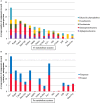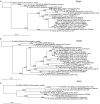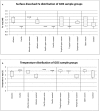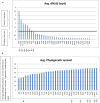Factors influencing the diversity of iron uptake systems in aquatic microorganisms
- PMID: 23087680
- PMCID: PMC3475125
- DOI: 10.3389/fmicb.2012.00362
Factors influencing the diversity of iron uptake systems in aquatic microorganisms
Abstract
Iron (Fe) is an essential micronutrient for many processes in all living cells. Dissolved Fe (dFe) concentrations in the ocean are of the order of a few nM, and Fe is often a factor limiting primary production. Bioavailability of Fe in aquatic environments is believed to be primarily controlled through chelation by Fe-binding ligands. Marine microbes have evolved different mechanisms to cope with the scarcity of bioavailable dFe. Gradients in dFe concentrations and diversity of the Fe-ligand pool from coastal to open ocean waters have presumably imposed selection pressures that should be reflected in the genomes of microbial communities inhabiting the pelagic realm. We applied a hidden Markov model (HMM)-based search for proteins related to cellular iron metabolism, and in particular those involved in Fe uptake mechanisms in 164 microbial genomes belonging to diverse taxa and occupying different aquatic niches. A multivariate statistical approach demonstrated that in phototrophic organisms, there is a clear influence of the ecological niche on the diversity of Fe uptake systems. Extending the analyses to the metagenome database from the Global Ocean Sampling expedition, we demonstrated that the Fe uptake and homeostasis mechanisms differed significantly across marine niches defined by temperatures and dFe concentrations, and that this difference was linked to the distribution of microbial taxa in these niches. Using the dN/dS ratios (which signify the rate of non-synonymous mutations) of the nucleotide sequences, we identified that genes encoding for TonB, Ferritin, Ferric reductase, IdiA, ZupT, and Fe(2+) transport proteins FeoA and FeoB were evolving at a faster rate (positive selection pressure) while genes encoding ferrisiderophore, heme and Vitamin B12 uptake systems, siderophore biosynthesis, and IsiA and IsiB were under purifying selection pressure (evolving slowly).
Keywords: Fe limitation; Fe- binding ligands; aquatic niches; dN/dS ratio; eukaryotic phytoplankton; marine microbes; metagenomes; multivariate statistics.
Figures







Similar articles
-
Iron transporters in marine prokaryotic genomes and metagenomes.Environ Microbiol. 2012 Jan;14(1):114-28. doi: 10.1111/j.1462-2920.2011.02539.x. Epub 2011 Aug 30. Environ Microbiol. 2012. PMID: 21883791
-
Insights into the bioavailability of oceanic dissolved Fe from phytoplankton uptake kinetics.ISME J. 2020 May;14(5):1182-1193. doi: 10.1038/s41396-020-0597-3. Epub 2020 Feb 5. ISME J. 2020. PMID: 32024947 Free PMC article.
-
Probing the Bioavailability of Dissolved Iron to Marine Eukaryotic Phytoplankton Using In Situ Single Cell Iron Quotas.Global Biogeochem Cycles. 2021 Aug;35(8):e2021GB006979. doi: 10.1029/2021GB006979. Epub 2021 Aug 25. Global Biogeochem Cycles. 2021. PMID: 35865367 Free PMC article.
-
Towards the development of a new generation of whole-cell bioreporters to sense iron bioavailability in oceanic systems-learning from the case of Synechococcus sp. PCC7002 iron bioreporter.J Appl Microbiol. 2019 Nov;127(5):1291-1304. doi: 10.1111/jam.14277. Epub 2019 Jun 26. J Appl Microbiol. 2019. PMID: 30970168 Review.
-
Iron Uptake Mechanisms in Marine Phytoplankton.Front Microbiol. 2020 Nov 5;11:566691. doi: 10.3389/fmicb.2020.566691. eCollection 2020. Front Microbiol. 2020. PMID: 33250865 Free PMC article. Review.
Cited by
-
Coordinated transporter activity shapes high-affinity iron acquisition in cyanobacteria.ISME J. 2014 Feb;8(2):409-17. doi: 10.1038/ismej.2013.161. Epub 2013 Oct 3. ISME J. 2014. PMID: 24088625 Free PMC article.
-
Environmental selection pressures related to iron utilization are involved in the loss of the flavodoxin gene from the plant genome.Genome Biol Evol. 2015 Feb 16;7(3):750-67. doi: 10.1093/gbe/evv031. Genome Biol Evol. 2015. PMID: 25688107 Free PMC article.
-
Microbial iron acquisition is influenced by spatial and temporal conditions in a glacial influenced river and estuary system.Environ Microbiol. 2023 Dec;25(12):3450-3465. doi: 10.1111/1462-2920.16541. Epub 2023 Nov 13. Environ Microbiol. 2023. PMID: 37956696 Free PMC article.
-
Implementation of homology based and non-homology based computational methods for the identification and annotation of orphan enzymes: using Mycobacterium tuberculosis H37Rv as a case study.BMC Bioinformatics. 2020 Oct 19;21(1):466. doi: 10.1186/s12859-020-03794-x. BMC Bioinformatics. 2020. PMID: 33076816 Free PMC article.
-
The environmental bioinorganic chemistry of aquatic microbial organisms.Front Microbiol. 2013 Apr 25;4:100. doi: 10.3389/fmicb.2013.00100. eCollection 2013. Front Microbiol. 2013. PMID: 23630522 Free PMC article. No abstract available.
References
-
- Boye M., Aldrich A. P., Van Den Berg C. M. G., De Jong J. T. M., Veldhuis M., De Baar H. J. W. (2003). Horizontal gradient of the chemical speciation of iron in surface waters of the northeast Atlantic Ocean. Mar. Chem. 80, 129–14310.1016/S0304-4203(02)00102-0 - DOI
LinkOut - more resources
Full Text Sources

